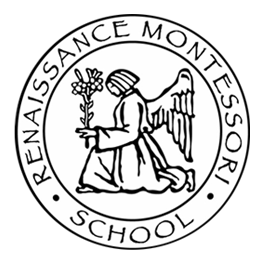By Jennifer Miller, Elementary Catechist
For the last two weeks in the Atrium, the Lower Elementary children have been contemplating the History of the Kingdom of God with a presentation commonly known as “The Fettuccia,” or “long, thin ribbon.” The main material of this work is a long ribbon, almost 100 yards, with moments of time marked in 4 different colors. If your child comes home asking for fettuccine or speaking a phrase that sounds Italian, this is why. The Fettuccia is a touchstone presentation in the Level II Atrium that is loved by all ages of the children.
We return to the Fettuccia every year, and it parallels one of the “Great Lessons” that Maria Montessori shared for the Elementary, “The Story of God Who Has No Hands” which also is repeated every year. The presentation gives an impression on the History of the Kingdom of God, placing it through time.
The first meeting with the children is sharing with them the story of Creation: In the beginning, there was nothing but God, and then slowly, carefully, deliberately and so beautifully he created everything. The last to be created was man and woman, all of creation was entrusted to them. They were different from all the other beings because they were made in the image and likeness of God. They can love others, think and use their hands. Then comes Redemption, when Jesus was born, died and rose from the dead for us all. After Jesus came, His light and love is to spread for all of mankind. Finally we talk about the time that has still not unfolded; we help work together to build the Kingdom of God to prepare for Parousia (also known as the Second Coming or the End of Time), when Christ will return and “God will be all in all.”
The second meeting of this presentation is with the materials, and there has been a buzz of expectation. The ribbon is longer than the length of the school building, so we bring the children outside for the unwinding of the ribbon. The children see and feel the ribs of the grosgrain ribbon. We don’t know how long it look for God to create the earth—no one was there but Him, so these ribs can symbolize 1 year, 100 years, or even 1000 years. The reel unfolds first a blue ribbon which marks creation before living things, then the ribbon changes to tan which marks the creation of plants and animals. The tan keeps unfolding, and towards the end there is an embroidered man and woman and a heart and hand. “Adam and Eve!” “Humans!” the children shout. Then there is a red cross symbolizing Jesus and another change of color to yellow, but it is a very short piece of ribbon. This is the time of Redemption. “Where are we on this ribbon?” The children take an arrow that has 2020 and point it to the very last rib of the yellow ribbon. But there are two more yards of white ribbon, ending in a brightly colored fringe of red and yellow. That white is the “Blank Page,” the future, the pages yet to be written. This is “our work” in building the Kingdom of God, to bring us to Parousia, the fringe on the end.
This reasoning and abstracting child is now contemplating the unity and vastness of history, and seeing the Golden Thread, a thread that ties us as people and creation together with God as the source.





